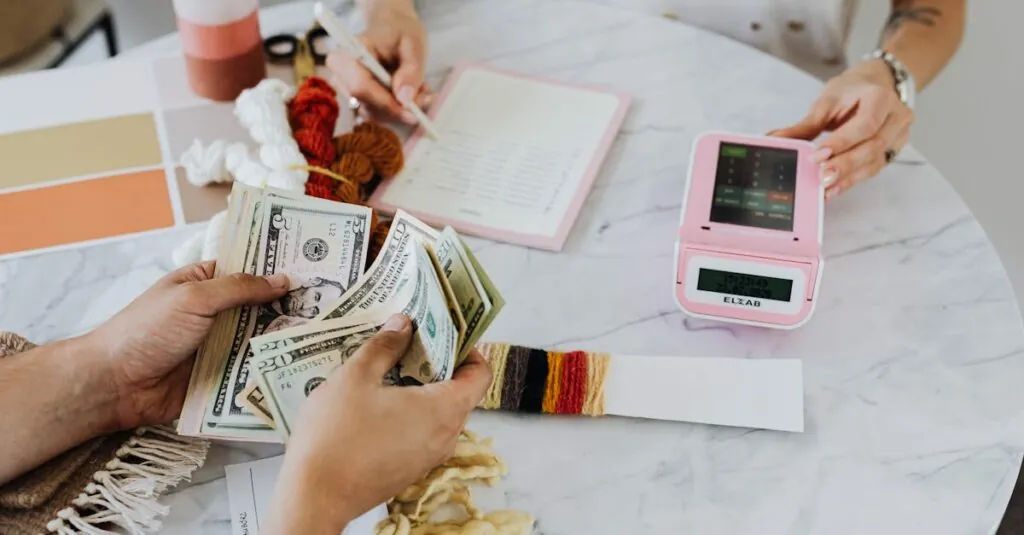Dreaming of homeownership but feeling weighed down by the burden of a hefty down payment? You’re not alone! Many aspiring homeowners find themselves in the same boat, wondering if they’ll ever escape the renting cycle. Luckily, there’s a silver lining. Loan options with no down payment are here to save the day, and they might just make your home-buying dreams come true faster than you can say “mortgage.”
Imagine strolling into your new home without having to drain your savings. Sounds like a fairy tale, right? Well, it’s not! With various no down payment loans available, buyers can unlock the door to their future without emptying their wallets. Whether it’s through government programs or special lender offerings, these options can help turn that “for sale” sign into “sold” in no time. Let’s dive into the world of no down payment loans and explore how they can pave the way to your new front porch.
Table of Contents
ToggleUnderstanding Loan Options With No Down Payment
No down payment loans offer a viable path to homeownership for many individuals. Various programs cater to different needs and financial situations, making home buying accessible.
One prominent option is the VA loan. This type of loan requires no down payment for eligible veterans and active-duty service members. Additionally, USDA loans provide another opportunity for buyers in rural areas, supporting those with lower to moderate incomes.
The FHA loan also deserves attention. Although it typically requires a small down payment, some lenders may offer options with minimal to no down payment, particularly for qualified buyers. Furthermore, certain state and local housing programs often assist buyers in overcoming barriers related to down payments.
Many lenders recognize the importance of accessibility in homeownership. They frequently offer special promotions for first-time buyers, which may include grants or programs that eliminate down payment obstacles. Exploring these options proves essential for aspiring homeowners seeking financial support.
Comparatively, private mortgage insurance may be necessary for loans with lower down payments. Choosing a no down payment loan could help avoid this extra cost, allowing buyers to allocate funds towards other expenses associated with homeownership.
Building awareness around no down payment options enables potential buyers to make informed decisions. Buyers may not realize how many resources and opportunities exist to support their journey toward homeownership. Taking the time to explore these options can pave the way for achieving their homeownership goals.
Types of Loan Options
Various loan types cater to those seeking homes without the burden of a down payment. These options make homeownership accessible to a wider audience.
Conventional Loans
Conventional loans often feature unique programs that provide no down payment options. Lenders may offer these loans to qualified buyers with strong credit profiles. Often, specific criteria must be met to qualify, including income verification and employment stability. No down payment programs can also come with competitive interest rates, making home loans more affordable. Many lenders partner with first-time buyer initiatives to extend these offerings, allowing buyers to enter the market without initial upfront costs.
Government-Backed Loans
Government-backed loans provide significant opportunities for potential buyers. The VA loan program caters to veterans and active-duty military members, enabling them to purchase homes without a down payment. Similarly, USDA loans support buyers in designated rural areas, also requiring no down payment. FHA loans, while traditionally requiring down payments, offer options for those who qualify based on specific criteria. Many government programs aim to enhance affordability and accessibility, allowing buyers to achieve homeownership while minimizing initial financial burdens.
Benefits of No Down Payment Loans
No down payment loans enhance access to homeownership for many individuals. These loans eliminate the upfront barrier that traditional mortgages present, benefiting a wider audience.
Increased Accessibility
Increased accessibility stands out as a significant advantage of no down payment loans. Borrowers who face challenges saving for a large down payment often find opportunities through these loan options. VA loans, USDA loans, and special promotions from lenders specifically cater to those with limited funds. By removing this up-front cost, prospective buyers transition more easily from renting to owning. Many individuals in underserved communities also gain the chance to invest in property, strengthening local economies.
Financial Flexibility
Financial flexibility represents another key benefit of no down payment loans. With no down payment, borrowers retain more cash for other expenses, such as closing costs and moving expenses. This availability of funds allows for better budgeting and planning, making it easier to manage monthly mortgage payments. A buyer with additional cash reserves might address unforeseen repairs or home improvements right after purchase. Overall, financial flexibility reduces stress and promotes long-term stability, making homeownership a more attainable goal.
Challenges of No Down Payment Loans
While no down payment loans offer accessible pathways to homeownership, potential challenges exist that buyers should consider.
Higher Monthly Payments
Higher monthly payments frequently accompany no down payment loans. Without an initial investment, borrowers finance the entire purchase price, leading to elevated monthly obligations. For instance, a home priced at $250,000 results in larger payments compared to a loan with a 20% down payment. Additionally, these higher costs may strain monthly budgets, limiting discretionary spending. Buyers should thoroughly assess their financial situations before committing to such loans, as these payments can impact long-term financial stability.
Potential for Private Mortgage Insurance (PMI)
Private mortgage insurance often becomes a requirement for no down payment loans. Lenders typically impose PMI to mitigate their risk in offering loans without a down payment, adding a recurring expense for borrowers. This monthly payment can range from 0.5% to 1% of the original loan amount. For example, with a $250,000 loan, PMI could add an additional $125 to $208 to monthly payments. Understanding this cost is crucial, as it adds to overall housing expenses and can diminish the financial benefits of securing a no down payment loan. Prospective buyers must factor in PMI when evaluating their options.
Exploring no down payment loan options opens the door to homeownership for many who thought it was out of reach. These loans not only alleviate the burden of large upfront costs but also empower individuals to invest in their future. By considering various programs like VA, USDA, and FHA loans, potential buyers can find solutions tailored to their needs.
While there are challenges such as higher monthly payments and potential PMI, the benefits often outweigh the drawbacks. With careful planning and research, aspiring homeowners can navigate these options effectively. Ultimately, no down payment loans represent a significant opportunity for those ready to transition from renting to owning their dream home.





